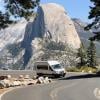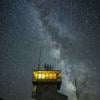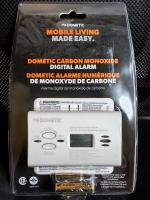Before I bought this CO detector/alarm, I bought (and later returned) this CO detector/alarm:
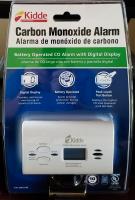
I bought this Kidde model (first) because it was, at the time, $25 on Amazon, and the Dometic-branded one was about $50 on Camping World and over $60 on Amazon. The plastic cases of the two units are absolutely identical (except for printing), features and specs are identical -- the only obvious difference I could see was that the more expensive one had a mounting bracket.
I didn't see that the convenience of a mounting bracket was worth ~$30, so I got the Kidde-branded one.
Before I purchased the Kidde I did some background reading and saw that both of the units listed an operating range of 40° - 100°F. OK, that's the operating range, and when I have the catalytic heater on (when I care about CO monitoring) the temperature will be >40°F, so it will "operate" fine.
But what about when I'm not running the heater, and it's winter, and it's maybe below freezing in the camper -- whether because I'm driving or away from the camper or when the camper is parked at my house in winter.
Do I need to keep the unit above 40F all the time?
These photos of the back of the Kidde and the Dometic packages show the differences (few) and similarities (many) of the two units.
Kidde:
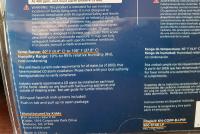
Dometic:
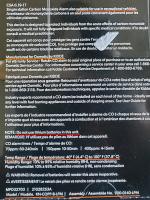
There are 2 or 3 different designations on each package that are called "model", so it's a bit confusing, but note that the Model that begins with "KN-..." is the same on both. And the Dometic unit says "Manufactured... by Kidde".
So...if these two units seem to be the same (except for the mounting bracket and labeling) why did I return the less-expensive Kidde unit and buy the more-expensive Dometic-branded unit?
Well, I'm still not 100% certain that they are different...but I based my decision on what customer service representatives told me in emails when I asked about storage in frigid temperatures, when not in use, and because the Dometic unit actually says OK for RV use.
Kidde: "The sensor has a slight amount of water in it that will be in danger of freezing. As well the battery will not last the full 10 years as the temperature is too cold and the charge will deplete. The warranty will also be voided."
Well, I'm not worried about the batteries. I figured I'd use lithium batteries, which are much more cold-tolerant than alkaline. (that was before I saw the anti-lithium warning on the Dometic package). But I get that freezing water could screw up something inside...
I asked Dometic a similar question about affect of cold temperatures on the unit when not in use.
Dometic: "Our recommendation is that you should remove the battery for the winter. You would not have to remove the entire unit, just the battery, keep in a temperate area during the winter."
That sounds good, I guess.
I asked Dometic a follow-up question, sent a picture of the Kidde package and asked if these are really the same unit?
Dometic: "It more than likely is the same thing. This is what we call a traded product. Meaning we buy it from another company and just slap our name on it. So Kidde probably does the same thing."
Hmmm....well, that doesn't seem to be true -- since both packages say "Manufactured by Kidde". And if they are the same thing then why different answers from different CS departments?
So, to get another opinion, I sent a the same "cold temperatures" question to customer service at etrailer.com -- an online RV product dealer which sells the Dometic unit.
etrailer: You asked a great question, so I made an answer page for you with additional information. You can see it here:
http://www.etrailer.com/question-345112.html?fb=yes
and that online answer was:
I spoke with my contact at Atwood to get clarification on the temperature range of the Atwood RV Carbon Monoxide Detector part # AT32703 and they told me that The alarm will ONLY work between 40 degrees and 100 degrees Fahrenheit. It can, however, be stored to a maximum of ten below to higher without harm.
OK, I was convinced. Whether they really are different...I don't really know. But because the Dometic/Atwood model actually says it's for RV use on the package, that's the one I kept.
I really should have bought it from etrailer, since they decided me (and immortalized my question on their website!  ) , but it was about $10 cheaper at Camping World, so I went for the bargain.
) , but it was about $10 cheaper at Camping World, so I went for the bargain.
Hmmm... still not sure about a couple of things, however:
1) When the etrailer CS guy says "..a maximum of ten below .." does he mean OK to 10 below zero °F, i.e., -10°F... or does he mean 10° below the operating range -- i.e., down to 30°F...? 
2) Hmmm...the product that etrailer sells is branded "Atwood", but I bought "Dometic", and the Dometic product has the same "32703" model number on it (among others). Isn't Dometic the same as Atwood now?
3) And why does the Dometic package say "Do not use lithium batteries in this unit"...?  Lithium batteries retain their power in cold temperatures much better than alkaline batteries. That's why I use them in the outdoor sensor unit of my little weather station.
Lithium batteries retain their power in cold temperatures much better than alkaline batteries. That's why I use them in the outdoor sensor unit of my little weather station.
4) And what chemistry, technology, do the OEM-mounted CO-alarm units use -- like the unit that came flush-mounted into the wall of my FWC camper when I bought it (and so, obviously, is not meant to be removed)...? Apparently they're not affected by cold-temperature storage. 
It's a puzzler... maybe I need to send another question to CS.
I'm usually not a big worrier about camper safety -- and I think my judgement is sound. But since I've convinced myself that I should have a CO detector (because of the catalytic heater, primarily), then it should be one that actually works in the conditions I plan to use it! 


